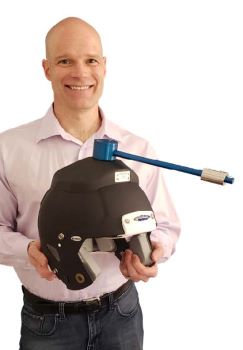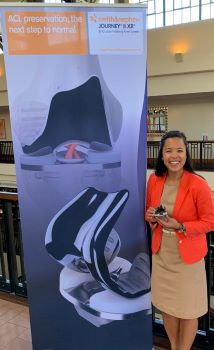Future leaders: branching out

Theodore Versteegh is no stranger to success. During an international technology pitch competition in 2019, the London, Ontario entrepreneur and Western University graduate won $50,000 for his company’s TopSpin360. His business produces specialized helmets that integrate innovation technology with the musculoskeletal (MSK) system. The goal of the device is to reduce the risk of concussions in high-impact sports by improving neck strength. This device is now used by athletes both internationally and here in Canada. This includes Western University’s top ranking varsity football team.
 Versteegh graduated from Western University’s Collaborative Training Program in Musculoskeletal Health Research (CMHR), a comprehensive program administered by BJI. After developing his idea for the TopSpin360; the program helped Versteegh pursue and successfully launch a start-up business. This enabled him to apply his knowledge and skill more broadly. “The great thing about the training program is the access it gives you to key researchers in various domains at Western,” Versteegh said. He added, “Learning the approaches of other disciplines can help immensely.” “CMHR opened the door to all aspects of MSK research going on at Western, the cutting edge of that research and its potential applications."
Versteegh graduated from Western University’s Collaborative Training Program in Musculoskeletal Health Research (CMHR), a comprehensive program administered by BJI. After developing his idea for the TopSpin360; the program helped Versteegh pursue and successfully launch a start-up business. This enabled him to apply his knowledge and skill more broadly. “The great thing about the training program is the access it gives you to key researchers in various domains at Western,” Versteegh said. He added, “Learning the approaches of other disciplines can help immensely.” “CMHR opened the door to all aspects of MSK research going on at Western, the cutting edge of that research and its potential applications."
CMHR started as a federally funded Canadian Institute of Health Research training program that included courses and transdisciplinary seminars. Now supported by BJI, CMHR continues to grow and expand with the addition of crossdiscipline mentorships as well as workshops in business and entrepreneurship delivered by the world-renowned Ivey Business School at Western University. Currently supporting over 100 trainees, the training program has produced more than 50 young MSK leaders in academia, research and industry in London and internationally.
Jennifer Ng, another early graduate of the training program, landed a technical position with an international orthopaedic company, Smith+Nephew. Ng’s career started in Boston, USA where she worked as a development engineer at a manufacturing facility, designing tools for surgeons operating on sports injuries.
 “It’s really cool to see your product out in the field being promoted and having surgeons use it,” Ng said. “A surgeon would come to us with an idea and say: ‘there’s this problem I want to solve’ . . . what I did was think about different designs to help them find solutions for those problems.”
“It’s really cool to see your product out in the field being promoted and having surgeons use it,” Ng said. “A surgeon would come to us with an idea and say: ‘there’s this problem I want to solve’ . . . what I did was think about different designs to help them find solutions for those problems.”
This type of transdisciplinary collaboration is not always intuitive and takes special skill. In BJI’s CMHR, trainees are encouraged to branch outside their own disciplines to learn from experts in other research areas including basic biological and biomedical sciences, physical sciences and engineering, clinical and health services, as well as population and community health. Engaging in these types of interactions empowers trainees to develop collaboration skills that enable them to find modern solutions for modern or long-standing problems.
Four years after she graduated from the training program, Ng was promoted to lead marketer in Smith+Nephew’s western U.S. headquarters, in Seattle, this time selling directly to U.S. surgeons.
With presentations on current research and breakthroughs, linkages to industry leaders, and discussions about both academic and business applications, the training program has benefits that go beyond standard education programs. Stewart McLachlin was a PhD candidate in orthopaedic biomechanics at Western University when BJI’s training program launched. He was working alongside surgeons at London’s Victoria Hospital to understand the biomechanics of the spine. It was through CMHR that he was exposed to other fields – helping him envision the “next generation of orthopaedic devices.” “I was able to get on board and learned about the engineering perspective,” said McLachlin, now an assistant professor in the Department of Mechanical and Mechatronics Engineering at the University of Waterloo. “The most important aspect of the training program, is its emphasis on the value of cross-disciplinary work and how it helps trainees develop those collaborations in a research setting” he added.
 “The training outside of my discipline has been really relevant,” McLachlin said. “There’s really a sense of community and a shared general interest in biomechanics, musculoskeletal bone and joint biomechanics.” It was the same for Ng, who said the training program opened her eyes to broader applications for biomedical engineering and biomedical devices. “It did give me further exposure to the fields outside orthopaedics,” Ng said. “I knew orthopaedics, and I knew that I wanted to get into orthopaedics . . . it opened my eyes to more aspects of the field.”
“The training outside of my discipline has been really relevant,” McLachlin said. “There’s really a sense of community and a shared general interest in biomechanics, musculoskeletal bone and joint biomechanics.” It was the same for Ng, who said the training program opened her eyes to broader applications for biomedical engineering and biomedical devices. “It did give me further exposure to the fields outside orthopaedics,” Ng said. “I knew orthopaedics, and I knew that I wanted to get into orthopaedics . . . it opened my eyes to more aspects of the field.”
Other success stories linked to BJI’s specialized training program include Paul Prowse, who is now the regional manager for clinical engineering at the Winnipeg Regional Health Authority, MB, and Amanda Lorbergs, manager (research and knowledge translation) with the Canada Frailty Network.
The CMHR program lays the groundwork and supports trainees to expand their knowledge and skills, giving everyone the opportunity to explore any aspect of MSK health that resonates with their interests and career ambitions. From industry to academia, to designing groundbreaking tools like The TopSpin360, trainees are finding success by branching out beyond their research disciplines.

